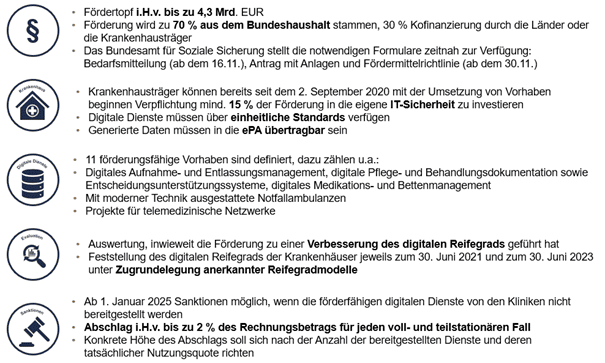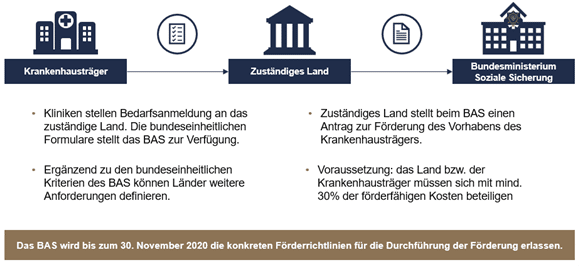At the beginning of October 2021, the Bundesrat and Bundestag passed the Hospital Future Act. Its contents are intended to help the German hospital sector to eliminate deficits in the digital transformation. The most important contents of this are recorded in this article.
The most important information at a glance

Where do hospitals stand today?
Germany’s hospitals lag far behind in an international comparison when it comes to digitization (Baierlein/Quandt 2020). According to a study for the Hospital Report 2019, the Ø EMRAM score (digitization maturity level according to an internationally recognized classification system) in 2017 was 2.3 on a scale of 0 to 7. There is still great potential for development, particularly in smaller hospitals and in hospitals with high economic deficits. One of the main reasons that is repeatedly put forward is the much-discussed investment backlog in German hospitals. Even if we hope that digitization will add a great deal of value to patient care and employee satisfaction, the initial investment costs can be high and must first be justified on the basis of a benefit that is as directly measurable as possible for patients, employees and/or the organization.
Key points of the Hospital Futures Act
On October 9, 2020, the Federal Council gave the go-ahead for the KHZG, which addresses precisely this hurdle, namely the financing of digitization projects. The homepage of the Federal Ministry of Health talks about a “digital update” for hospitals (BMG 2020). With a total of 4.3 billion euros in investment funds, hospitals are to be comprehensively transported into the digital age from January 1, 2021. 30 percent of the funding volume is to be covered by the states and/or hospital owners. A total of eleven eligible projects are defined. From interoperability between providers to digital emergency rooms, the projects cover a broad spectrum with a predominant and strong focus on processes (1-9) in hospitals. The following overview presents the 11 projects:
- Digital infrastructure in emergency rooms
- Patient portals for digital admission and discharge management and information exchange between the various service providers
- Continuous electronic documentation of care and treatment services and the establishment of systems for automated and voice-based documentation.
- Partially or fully automated clinical decision support systems to increase the quality of care in treatment decisions.
- End-to-end digital medication management to increase drug therapy safety
- In-house hospital digital process for requesting services and improving communication processes
- Allowable measures to coordinate service delivery among multiple hospitals to ensure universal coverage, as well as the provision of secure systems
- Introduction and further development of an online-based care record system for beds
- Expansion of telemedical network structures between hospitals and outpatient facilities
- Measures to ensure the functionality and security of the patient information processed.
- Adaptation of patient rooms to the special treatment requirements in the event of an epidemic
In addition to the content-related criteria, initial mostly more technically oriented criteria have already been defined that must be met for funding:
- Interoperability of digital services through internationally recognized technical, syntactic and semantic standards
- Compliance with the specifications for the integration of open and standardized interfaces
- Transferability of relevant data and documents to the electronic patient record
- Ensuring information security and compliance with data protection regulations
- Applications for the telematics infrastructure are to be used across measures if they are available
The funding procedure
The Federal Social Security Agency (BAS) is responsible for the overarching appropriation of funds from the Hospital Futures Act investment program. From the time the law goes into effect until December 31, 2021, states can submit applications for funding to the Federal Social Security Office. The necessary forms should be made available from mid-November.
The core process for applying for funding is as follows:

In addition, it is stipulated that the eligibility of certain projects must be examined in advance. The Federal Social Security Office will provide a training program to enable employees of IT service providers with the appropriate qualifications to do this. Confirmation of a positive test must be attached to the application. Both the specific funding guideline from the Federal Office for Social Security as well as the possible funding guideline from the Federal Office for Social Security apply. criteria defined by the countries themselves in order to be able to provide further information on the procedure and requirements. The BAS website is expected to have the needs assessment forms available by Nov. 16, 2020. The complete applications incl. facilities as of Nov. 30, 2020, as well as the grant guidelines themselves. The online training program for IT service providers is not scheduled to start until Jan. 1, 2021.
Evaluation
The evaluation of the investment program is to be accompanied by a research project. The aim is to develop a model specific to Germany based on existing and recognized maturity models. Hospitals are to determine their digital maturity level as part of structured self-assessments. The effectiveness of the Hospital Future Fund and the new digital services introduced as a result will be evaluated in terms of a before-and-after comparison. A first measurement is scheduled for June 30, 2021; another is then scheduled for June 30, 2023.
There are already some models on the market specific to hospitals for measuring digital maturity. In addition to what is certainly one of the best-known models of HIMMS (EMRAM), the College of Health Information Management Executives (CHiME) also offers a measurement tool for digitization. A model developed specifically for the German market (Check IT) has emerged from a joint project of the Bundesverband Gesundheits-IT (bvitg e.V.) and the Marburger Bund. It is not yet clear which models will serve as the basis for the evaluation measurement tool.
Sanctions
As of January 1, 2025, sanctions are possible for all hospitals that do not have the necessary digital services in accordance with the Hospital Structural Fund Ordinance. The contracting parties may agree on a discount of up to 2% of the invoice amount for each full and partial inpatient case. The decisive factor is the provision of digital services Nos. 2 to 6 of the Hospital Structural Fund Ordinance. These include: Patient portals for admission and discharge management, end-to-end electronic medical records, clinical decision support systems, digital medication management, and digital service requirements (see Figure 2: Overview of eligible projects). The more digital services are provided, the lower the discount.
In light of the current Corona crisis and the accompanying challenges for hospitals, both medical and financial, the 5-year period can be viewed critically. The past few months have shown that hospitals are rightly going into crisis mode to focus human resources and concentrate on the essentials – providing medical services to manage the crisis. In addition, sanctions will exacerbate the already strained economic situation of many houses and create additional economic pressure.
KHZG – Quo vadis?
A design-intensive process lies ahead for the clinics. The challenge is to synchronize (clinical) processes with the IT landscape so that the organization, information technology and the people involved can work hand in hand to provide the best possible service in the interests of medicine and the patient. Digitization will be with us for years and decades to come; it is a process of change that thrives on the further development of technical possibilities.
We must learn to evaluate the opportunities and risks of digitization again and again in order to approach the digital world step by step and exploit its potential. At the same time, we must expect the proportion of loss-making hospitals to continue to rise, especially in times of Corona. It remains to be seen whether the KHZG cash injection will actually accelerate the digitization of hospitals to the necessary extent, or whether there will have to be a fundamental change in the (re)financing of hospitals in order to enable them to invest in the digital world in the long term. This is because systems also usually need more than one update to ensure their stability and security on an ongoing basis.















